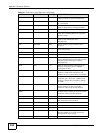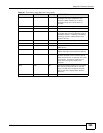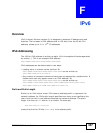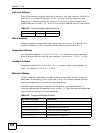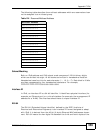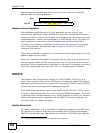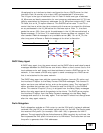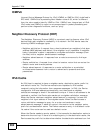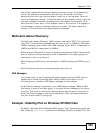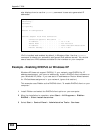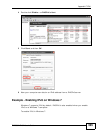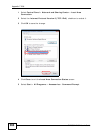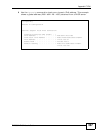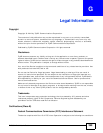
Appendix F IPv6
EMG5324-D10A User’s Guide
362
ICMPv6
Internet Control Message Protocol for IPv6 (ICMPv6 or ICMP for IPv6) is defined in
RFC 4443. ICMPv6 has a preceding Next Header value of 58, which is different
from the value used to identify ICMP for IPv4. ICMPv6 is an integral part of IPv6.
IPv6 nodes use ICMPv6 to report errors encountered in packet processing and
perform other diagnostic functions, such as "ping".
Neighbor Discovery Protocol (NDP)
The Neighbor Discovery Protocol (NDP) is a protocol used to discover other IPv6
devices and track neighbor’s reachability in a network. An IPv6 device uses the
following ICMPv6 messages types:
• Neighbor solicitation: A request from a host to determine a neighbor’s link-layer
address (MAC address) and detect if the neighbor is still reachable. A neighbor
being “reachable” means it responds to a neighbor solicitation message (from
the host) with a neighbor advertisement message.
• Neighbor advertisement: A response from a node to announce its link-layer
address.
• Router solicitation: A request from a host to locate a router that can act as the
default router and forward packets.
• Router advertisement: A response to a router solicitation or a periodical
multicast advertisement from a router to advertise its presence and other
parameters.
IPv6 Cache
An IPv6 host is required to have a neighbor cache, destination cache, prefix list
and default router list. The Device maintains and updates its IPv6 caches
constantly using the information from response messages. In IPv6, the Device
configures a link-local address automatically, and then sends a neighbor
solicitation message to check if the address is unique. If there is an address to be
resolved or verified, the Device also sends out a neighbor solicitation message.
When the Device receives a neighbor advertisement in response, it stores the
neighbor’s link-layer address in the neighbor cache. When the Device uses a
router solicitation message to query for a router and receives a router
advertisement message, it adds the router’s information to the neighbor cache,
prefix list and destination cache. The Device creates an entry in the default router
list cache if the router can be used as a default router.
When the Device needs to send a packet, it first consults the destination cache to
determine the next hop. If there is no matching entry in the destination cache, the
Device uses the prefix list to determine whether the destination address is on-link



